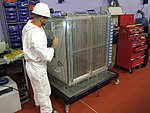UK Dark Matter Collaboration
Experiments for dark matter searchLaboratories in the United KingdomResearch institutes in North YorkshireScience and technology in the United KingdomSubterranea of the United Kingdom ... and 2 more
Underground laboratoriesUse British English from September 2022

The UK Dark Matter Collaboration (UKDMC) (1987–2007) was an experiment to search for Weakly interacting massive particles (WIMPs). The consortium consisted of astrophysicists and particle physicists from the United Kingdom, who conducted experiments with the ultimate goal of detecting rare scattering events which would occur if galactic dark matter consists largely of a new heavy neutral particle. Detectors were set up 1,100 m (3,600 ft) underground in a halite seam at the Boulby Mine in North Yorkshire.
Excerpt from the Wikipedia article UK Dark Matter Collaboration (License: CC BY-SA 3.0, Authors, Images).UK Dark Matter Collaboration
Whitby Road,
Geographical coordinates (GPS) Address Nearby Places Show on map
Geographical coordinates (GPS)
| Latitude | Longitude |
|---|---|
| N 54.5534 ° | E -0.8245 ° |
Address
Whitby Road
TS13 4UJ
England, United Kingdom
Open on Google Maps









